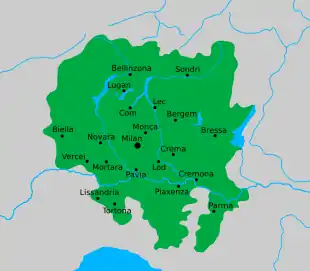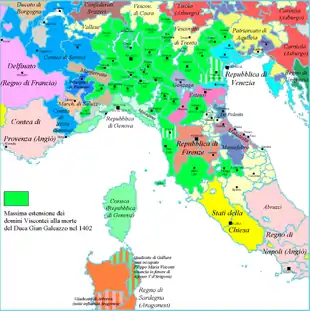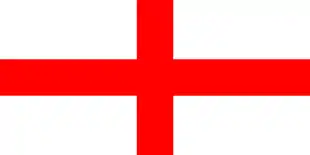Duchy of Milan
The Duchy of Milan was an Italian state located in northern Italy. The Duchy was created in 1395 by Gian Galeazzo Visconti, then the Lord of Milan, and a member of the important Visconti family, that had been ruling the city since 1277.[1][2]
Duchy of Milan Ducato di Milano (in Italian) Ducatus Mediolani (in Latin) | |||||||||||||||
|---|---|---|---|---|---|---|---|---|---|---|---|---|---|---|---|
| 1395–1447 1450–1796 | |||||||||||||||
-en.svg.png.webp) Duchy of Milan in 1494 | |||||||||||||||
| Status | Duchy ruled by the Milanese nobility (1395–1499; 1512–1515; 1521–1540) Crown land of France (1499–1512; 1515–1521) Territory of Habsburg Spain (1556–1707) Crown land of the Austrian Branch of the Habsburg Monarchy (1707–1795) | ||||||||||||||
| Capital | Milan | ||||||||||||||
| Common languages | Lombard Italian | ||||||||||||||
| Religion | Roman Catholicism | ||||||||||||||
| Government | Princely hereditary monarchy | ||||||||||||||
| Duke | |||||||||||||||
• 1395–1402 | Gian Galeazzo Visconti (first) | ||||||||||||||
• 1792–1796 | Francis II (last) | ||||||||||||||
| Historical era | Early Modern | ||||||||||||||
| May 1 1395 | |||||||||||||||
| 1447–1450 | |||||||||||||||
• French Occupation | 1499–1512, 1515–1522 and 1524–1525 | ||||||||||||||
• Habsburg rule | 1535–1796 | ||||||||||||||
• Spanish rule | 1556-1700 | ||||||||||||||
• Austrian rule | 1700–1796 | ||||||||||||||
• Annexation to the Transpadane Republic | November 15 1796 | ||||||||||||||
| Population | |||||||||||||||
• Estimate | 750,000 in the 17th century | ||||||||||||||
| Currency | Milanese scudo, lira and soldo | ||||||||||||||
| |||||||||||||||
| Today part of | |||||||||||||||
At that time, it included twenty-six towns and the wide rural area of the middle Padan Plain east of the hills of Montferrat. During much of its existence, it was wedged between Savoy to the west, Venice to the east, the Swiss Confederacy to the north, and separated from the Mediterranean by Genoa to the south. The Duchy was at its largest at the beginning of the 15th century, at which time it included almost of what is now Lombardy and parts of what are now Piedmont, Veneto and Emilia-Romagna.[2]
Under the House of Sforza, Milan experienced a period of great prosperity with the introduction of the silk industry, becoming one of the wealthiest states during the Renaissance.[3]
From late 15th century the Duchy of Milan was contested between the forces of the Holy Roman Empire and the Kingdom of France. It was ruled by Habsburg Spain from 1556 and it passed to Habsburg Austria in 1707 during the War of the Spanish Succession as a vacant Imperial fief.[4] The Duchy remained an Austrian possession until 1796, when a French army under Napoleon Bonaparte conquered it, and it ceased to exist a year later as a result of the Treaty of Campo Formio, when Austria ceded it to the new Cisalpine Republic.[5]
After the defeat of Napoleon, the Congress of Vienna of 1815 restored many other states which he had destroyed, but not the Duchy of Milan. Instead, its former territory became part of the Kingdom of Lombardy–Venetia, with the Emperor of Austria as its king. In 1859, Lombardy was ceded to the Kingdom of Piedmont-Sardinia, which would become the Kingdom of Italy in 1861.
History

The House of Visconti had ruled Milan since 1277, in which year Ottone Visconti defeated Napoleone della Torre. The Duchy of Milan (Ducatus Mediolani) as a state of the Holy Roman Empire was created on 1 May 1395, when Gian Galeazzo Visconti, purchased a diploma for 100,000 Florins from King Wenceslaus.[6] It was this diploma that installed Visconti as Duke of Milan and Count of Pavia.[7]
Visconti rule (1395–1447)
The Duchy, as defined in the diploma of 1395, included the territory surrounding Milan, between the Adda and Ticino rivers,[8] but the dominions of Gian Galeazzo Visconti extended beyond, including 26 towns and spanned from Piedmont to Veneto and from present-day Canton of Ticino to Umbria.[9][10] Milan thus became one of the five major states of the Italian peninsula in the 15th century. The House of Visconti had been expanding their dominions for nearly a century, under the reigns of Azzone Visconti, Luchino Visconti, Giovanni Visconti, Bernabò Visconti and Gian Galeazzo Visconti: during the rule of Azzone Visconti, the Ossola in Piedmont had been conquered in 1331, followed by Bergamo and Pavia (Lombardy) and Novara (Piedmont) in 1332, Pontremoli (Tuscany) in 1333, Vercelli (Piedmont) and Cremona (Lombardy) in 1334, the Lombard cities of Como, Crema, Lodi and the Valtellina in 1335, Bormio (Lombardy) and Piacenza (Emilia) in 1336, and Brescia and the Val Camonica in 1337.[11]

The brothers Luchino and Giovanni Visconti added Bellinzona (present-day Switzerland in 1342, Parma (Emilia) in 1346 and several territories in southwestern Piedmont in 1347: Tortona, Alessandria, Asti, and Mondovì. Bernabò conquered Reggio Emilia in 1371 and Riva del Garda in 1380, and Gian Galeazzo greatly expanded Milan's dominions, first eastwards, with the conquest of the Venetian cities of Verona (1387), Vicenza (1387), Feltre (1388), Belluno (1388) and Padova (briefly, from 1388 to 1390), and later southwards, conquering Lucca, Pisa and Siena in Tuscany in 1399, Bologna in Emilia in 1402, and Perugia and Assisi in Umbria also in 1402.
Ambrosian Republic (1447–1450)
When the last Visconti Duke, Filippo Maria, died in 1447 without a male heir, the Milanese declared the so-called Golden Ambrosian Republic, which soon faced revolts and attacks from its neighbors.[12] In 1450 mercenary captain Francesco Sforza, having previously married Filippo Maria Visconti's illegitimate daughter Bianca Maria, conquered the city and restored the Duchy, founding the House of Sforza.[13]
Sforza rule (1450–1499)
Whilst ruled by the Visconti and Sforza, the duchy had to defend its territory against the Swiss, the French and the Venetians, until Ludovico Sforza was handed over to the French in the 'Betrayal of Novara' in April 1500, thus enabling the new French king Louis XII to successfully assert his claim to the duchy.[14]
French rule (1499–1526)
In 1498, the Duke of Orleans became King of France as Louis XII, and immediately sought to make good his father's claim to Milan. He invaded in 1499 and soon ousted Lodovico Sforza. The French ruled the duchy until 1512, when they were ousted by the Swiss, who put Lodovico's son Massimiliano on the throne. Massimiliano's reign did not last very long. The French, now under Francis I, invaded the area in 1515 and reasserted their control at the Battle of Marignano. The French took Massimiliano as their prisoner. The French were again driven out in 1521, this time by the Austrians, who installed Massimiliano's younger brother, Francesco II Sforza.
Following the French defeat at Pavia in 1525, which left the imperial armies of Charles V dominant in Italy, Francesco joined the League of Cognac against the emperor along with Venice, Florence, the Pope, and the French. This resulted quickly in his own expulsion from Milan by imperial forces, but he managed to remain in control of various other cities in the duchy, and was again restored to Milan itself by the peace concluded at Cambrai in 1529.
In 1535, Francesco died without heirs, the question of succession again arose, with both the emperor and the King of France claiming the duchy, leading to more wars. The Duchy of Parma was created in 1545 from a part of the Duchy of Milan south of the Po River, as a fief for Pope Paul III's illegitimate son, Pier Luigi Farnese, centered on the city of Parma.
Spanish Habsburg rule (1556–1707)
The emperor Charles V, Holy Roman Emperor held the duchy from 1535, eventually granting it to his son Philip II, King of Spain from 1556. The possession of the duchy by Habsburg Spain was finally recognized by the French in the Treaty of Cateau-Cambrésis in 1559.
The Duchy of Milan remained in Habsburg Spain hands until the War of the Spanish Succession (1701-1714), when the Austrians invaded it (1701) and obtained it with the Convention of Milan in 1707.
Austrian Habsburg rule (1714–1796)
The duchy remained in Austrian hands until it was overrun by the French army of Napoleon Bonaparte in 1796. The duchy was ceded by Austria in the Treaty of Campo Formio in 1797, and formed the central part of the new Cisalpine Republic.
Legacy
After the defeat of Napoleon, based on the decisions of the Congress of Vienna on 9 June 1815, the Duchy of Milan was not restored. The Duchy instead became part of the Kingdom of Lombardy–Venetia, a constituent of the Austrian Empire and with the Emperor of Austria as its king. This kingdom ceased to exist when the remaining portion of it was annexed to the Kingdom of Italy in 1866.
References
- Black (2009), pp. 68–72
- "::: Storia di Milano ::: dal 1201 al 1225". www.storiadimilano.it. Retrieved 2020-07-01.
- "Milan - History". Encyclopedia Britannica. Retrieved 2020-12-17.
- "Storia di Milano ::: dal 1701 al 1725". www.storiadimilano.it. Retrieved 2020-07-01.
- "Storia di Milano ::: dal 1776 al 1800". www.storiadimilano.it. Retrieved 2020-07-01.
- Bueno (1941), p. 173
- Bueno (1941), p. 190
- Black (2009), p. 69
- Bueno (1941), pp. 174–301
- Knight, Charles (1855). The English cyclopedia: geography. London.
- "VISCONTI".
- Aeneas Sylvius Piccolomini (Pope Pius II), The Commentaries of Pius II (Northampton, Massachusetts, 1936-37) pp. 46, 52.
- Cecilia M. Ady, A History of Milan under the Sforza, ed. Edward Armstrong (London, 1907) pp. 56-60.
- Cartwright, Julia (1899). Beatrice d'Este, Duchess of Milan, 1475–1497: A Study of the Renaissance. Hallandale.
Sources
- Black, Jane (2009). Absolutism in Renaissance Milan. Plenitude of power under the Visconti and the Sforza 1329–1535. Oxford: Oxford University Press. ISBN 9780199565290.
- Bueno de Mesquita, Daniel Meredith (1941). Giangaleazzo Visconti, Duke of Milan (1351-1402): a study in the political career of an Italian despot. Cambridge: Cambridge University Press. ISBN 9780521234559. OCLC 837985673.

.svg.png.webp)

